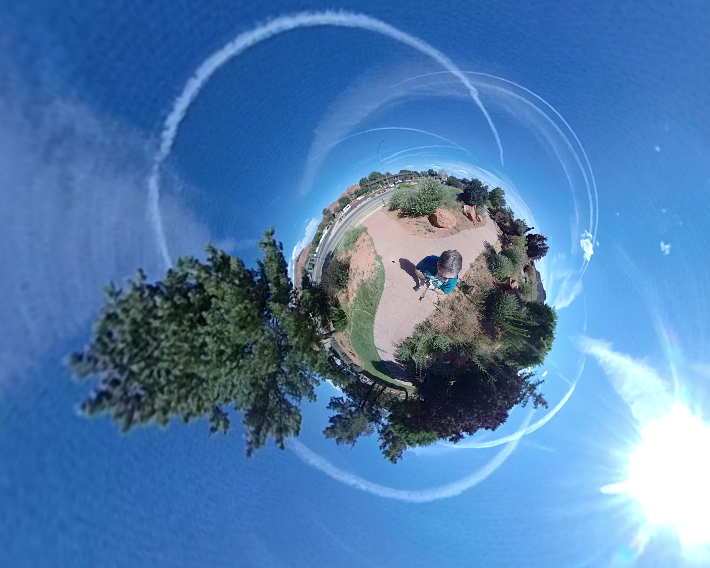Recently I have been exploring the MP4 format, more specifically the ISO Base Media File Format. It appears to be quite the versatile format. Based on the general Box/Atom format. Don’t mean to go much into the format here as there are so many formats which use this structure, like Quicktime MOV, Jpeg2000, to the more recent Canon RAW CR3. I have also been digging into the DASH MP4 format, but we’ll save that for a later time.
One of the more interesting uses of MP4 lately is 360 or spherical video. They are becoming more and more popular with content creators and also used for mapping like Google street view.
A while back I picked up a Insta360 Nano S camera. It attached directly to my iPhone. With a camera on each side it could capture images and video which could later be processed to produce some interesting results.

Of course it needs to be processed first so it doesn’t look like you are peering out of your peephole. Insta360 provides software for you to process the video into a regular video or some fun creative spherical video that makes you look like you are walking on a small globe.

The formats produced by the Insta360 Nano S are plain old JPG and MP4, but uses the extensions .INSP and .INSV respectively. Neither of which are documented in PRONOM yet. But because of the nature of 360 camera’s there is a little more under the hood. If you would like to look at some samples you can find some here.
The INSP file begins like any other EXIF JPEG file, but ends with a little additional info.

The 360 cameras have some additional information from the different gyros and accelerometers, as well as GPS information. The INSP file stores much of this information after the end of the JPG format. You can also see a string of alphanumeric numbers at the end, which is consistent with most of the files I have seen. One python parser of the additional data calls it the magic number. “8db42d694ccc418790edff439fe026bf” would make a good pattern for a signature.
The INSV files are similar, except they use the MP4 base media format.

Mediainfo indeed sees the file as an MPEG-4 with a AVC codec, but with a invalid extension.
Complete name : VID_20210222_170428_005.insv Format : MPEG-4 Format profile : JVT Codec ID : avc1 (avc1/isom) File size : 41.1 MiB Duration : 7 s 608 ms Overall bit rate mode : Variable Overall bit rate : 45.4 Mb/s Encoded date : UTC 2021-02-22 17:04:18 Tagged date : UTC 2021-02-22 17:04:18 IsTruncated : Yes FileExtension_Invalid : braw mov mp4 m4v m4a m4b m4p m4r 3ga 3gpa 3gpp 3gp 3gpp2 3g2 k3g jpm jpx mqv ismv isma ismt f4a f4b f4v
In addition to a video and audio track, there is a text track.
Text ID : 3 Format : Timed Text Codec ID : text Duration : 7 s 600 ms Bit rate mode : Constant Bit rate : 240 b/s Frame rate : 10.000 FPS Stream size : 228 Bytes (0%) Title : Ambarella EXT Language : English Forced : No Encoded date : UTC 2021-02-22 17:04:18 Tagged date : UTC 2021-02-22 17:04:18
With a little Exiftool magic, thank you Phil, we can see some of the extra data within the video file.
Serial Number : ISS2418ND7XH4H Model : Insta360 Nano S Firmware : v1.17.12.3_build1 Parameters : 2 947.866 946.388 964.646 0.000 0.000 90.000 942.993 2891.656 952.520 -0.682 -1.501 89.186 3840 1920 1040 Preview Image : (Binary data 578944 bytes, use -b option to extract) Time Code : 62.155 Accelerometer : 0.0717358812689781 0.837667405605316 -0.541449248790741 Angular Velocity : -0.00380666344426572 -0.0143540045246482 0.0170918852090836
Thanks to tools like Exiftool and MediaInfo we can take a peek into some of these formats. New ways of using the existing formats and new formats entirely keep popping up making it hard to know exactly what you have. Initially I just assumed the Insta360 formats didn’t need anything extra as they just used well known format with their own extension, but I needed to look a little closer. Many other cameras are now putting additional data at the end of a standard JPG. It will be interesting to see what new ideas camera developers come up in the coming years.
GoPro has a 360 camera as well and looking at a sample .360 file, I can see it also uses an MP4 base media format, but uses two video tracks to store video from the two cameras. Might need to dig into that format soon as well.